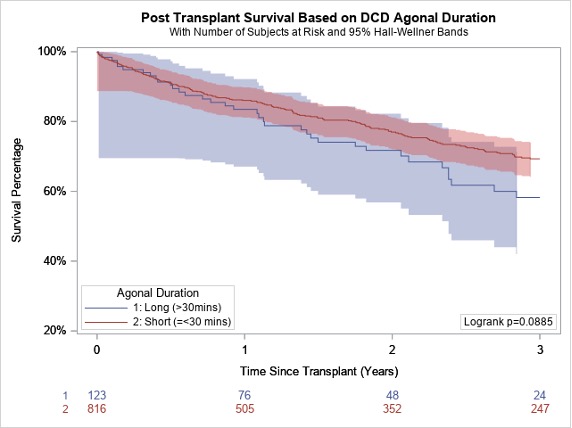Impact of Long Agonal Duration on Outcomes After Donation After Circulatory Death Lung Transplantation: An Analysis of the United Network of Organ Sharing Database
Department of Cardiac Surgery, Smidt Heart Institute, Cedars-Sinai Medical Center, Los Angeles, CA
Meeting: 2022 American Transplant Congress
Abstract number: 333
Keywords: Donors, non-heart-beating, Lung transplantation, Outcome, Survival
Topic: Clinical Science » Lung » 64 - Lung: All Topics
Session Information
Session Name: Early and Late Outcomes in Lung Transplantation
Session Type: Rapid Fire Oral Abstract
Date: Monday, June 6, 2022
Session Time: 5:30pm-7:00pm
 Presentation Time: 5:30pm-5:40pm
Presentation Time: 5:30pm-5:40pm
Location: Hynes Room 210
*Purpose: Lung transplantation (LTx) using donation after circulatory death (DCD) donors has been well established, however, previous investigators have focused on time from withdrawal of life support, rather than start of the agonal phase, to assess impact of agonal duration (AD) on mid-term outcomes.
*Methods: The United Network for Organ Sharing database was used to identify 939 isolated adult LTx recipients from 903 controlled DCD donors between 1/1/2010 and 6/30/2021. Recipients who received donor lungs with AD ≤ 30 minutes (short, n=816) were compared to those who received donor lungs with AD >30 minutes (long, n=123). AD was calculated as the time from the start of agonal phase (defined as when donor systolic blood pressure is <80 mmHg or oxygen saturation < 80%) to death confirmation. Death confirmation time was missing in 164 donors and was imputed using the median duration between death confirmation and aortic cross-clamp for the remainder of the cohort. Primary outcome was 3-year survival, analyzed with the Kaplan Meier method and adjusted with multivariable Cox regression.
*Results: Median AD was 15 (interquartile range, IQR, 11-19) and 41 (IQR, 35-56) minutes for the short and long AD cohorts, respectively. Baseline donor and recipient characteristics were similar between cohorts except for lower incidence of previous LTx in recipients of donors with short AD (2.3% vs 5.7%, p=0.03). After LTx, there were no differences in acute rejection episodes before discharge (11.2% vs 13.0%, p=0.79) or hospital length of stay (22, IQR 14-38 vs. 25, IQR 15-46 days, p=0.27). Thirty-day (97.7% vs 98.4%, p=0.58), 90-day (94.9% vs 94.9%, p=1) and 1-year (86.0%, 95% confidence interval (CI), 81.1-89.8%, vs 83.5%, 95% CI 67.1-97.2%, p=0.53) survival were similar between cohorts. Three-year unadjusted survival was numerically lower in the long AD cohort, (69.3%, 95% CI 64.1-73.9%, vs 58.2%, 95% CI 42.0-71.4%, p=0.089) (Figure). In multivariable Cox regression, AD > 30 minutes was an independent predictor 3-year mortality (Hazard ratio 1.60, 95% CI 1.11-2.30, p=0.011) along with recipient age, pre-transplant extracorporeal membrane oxygenation, and declined functional status.
*Conclusions: After risk-adjustment, donor agonal duration beyond 30 minutes was associated with inferior mid-term survival after LTx. This finding may help guide DCD donor selection in terms of maximizing organ acceptance rate without compromising post transplant mortality as a result of warm ischemia.
To cite this abstract in AMA style:
Thomas J, Chen Q, Chikwe J, Emerson D, Megna D, Catarino P. Impact of Long Agonal Duration on Outcomes After Donation After Circulatory Death Lung Transplantation: An Analysis of the United Network of Organ Sharing Database [abstract]. Am J Transplant. 2022; 22 (suppl 3). https://atcmeetingabstracts.com/abstract/impact-of-long-agonal-duration-on-outcomes-after-donation-after-circulatory-death-lung-transplantation-an-analysis-of-the-united-network-of-organ-sharing-database/. Accessed December 19, 2025.« Back to 2022 American Transplant Congress

